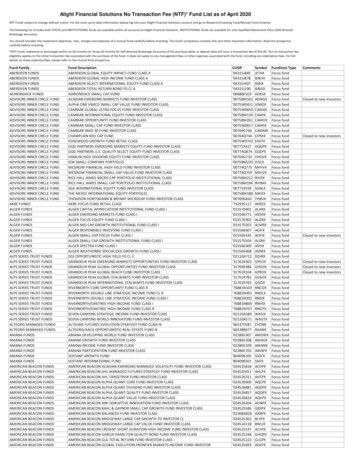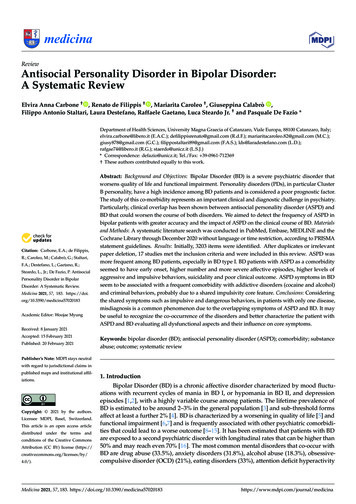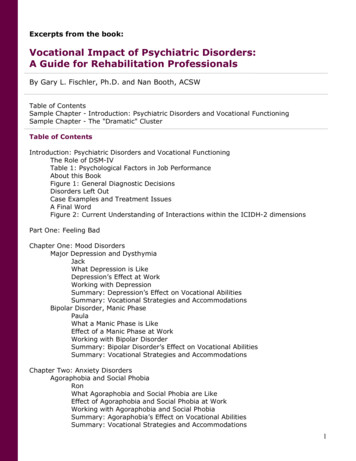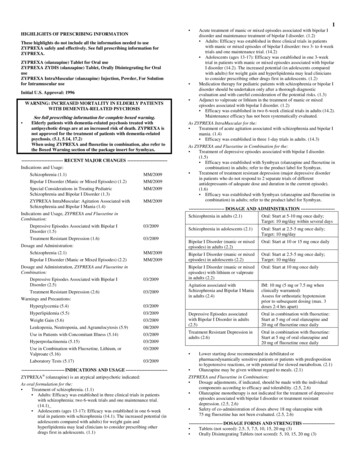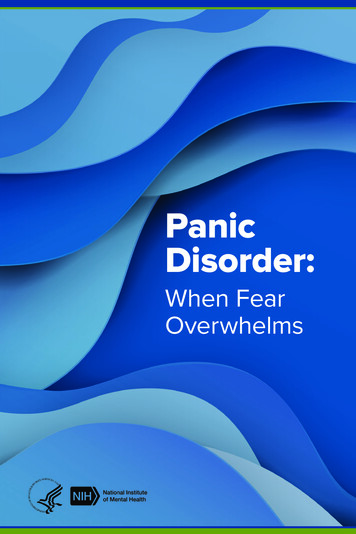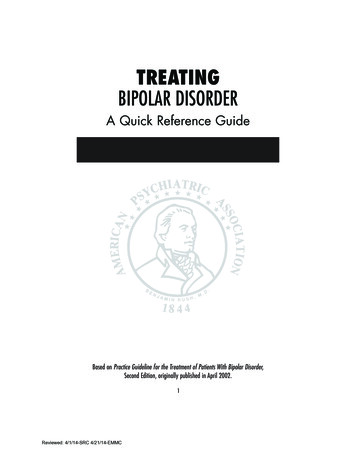
Transcription
TREATINGBIPOLAR DISORDERA Quick Reference GuideBased on Practice Guideline for the Treatment of Patients With Bipolar Disorder,Second Edition, originally published in April 2002.1Reviewed: 4/1/14-SRC 4/21/14-EMMC
For Continuing Medical Education creditfor APA Practice Guidelines,visit www.psych.org/cme.To order individual Practice Guidelines or the2002 Compendium of APA Practice Guidelines,visit www.appi.org or call 800-368-5777.Reviewed: 4/1/14-SRC 4/21/14-EMMC
TREATING BIPOLAR DISORDER 3Introduction“Treating Patients With Bipolar Disorder: A Quick Reference Guide” is asummary and synopsis of the American Psychiatric Association’s PracticeGuideline for the Treatment of Patients With Bipolar Disorder, which wasoriginally published in The American Journal of Psychiatry in April 2002and is available through American Psychiatric Publishing, Inc. The QuickReference Guide is not designed to stand on its own and should be usedin conjunction with the full text of the Practice Guideline. Algorithms illustrating the treatment of bipolar disorder are included.Statement of IntentThe Practice Guidelines and the Quick Reference Guides are not intended to be construed or to serve as a standard of medical care. Standardsof medical care are determined on the basis of all clinical data availablefor an individual case and are subject to change as scientific knowledgeand technology advance and practice patterns evolve. These parametersof practice should be considered guidelines only. Adherence to them willnot ensure a successful outcome in every case, nor should they be construed as including all proper methods of care or excluding other acceptable methods of care aimed at the same results. The ultimate judgmentregarding a particular clinical procedure or treatment plan must be madeby the psychiatrist in light of the clinical data presented by the patientand the diagnostic and treatment options available.The development of the APA Practice Guidelines and Quick ReferenceGuides has not been financially supported by any commercial organization.Reviewed: 4/1/14-SRC 4/21/14-EMMC
4 TREATING BIPOLAR DISORDEROUTLINEB. Treatment Options1. Acute Manic orMixed Episodes.102. Acute Depression.123. Rapid Cycling .134. Maintenance.14C. AdditionalInformation AboutPharmacotherapeuticAgents1. Lithium .162. Divalproex/Valproate/Valproic Acid .183. Carbamazepine .204. Olanzapine .225. Lamotrigine.23Reviewed: 4/1/14-SRC 4/21/14-EMMCA. PsychiatricManagement1. Perform a diagnosticevaluation.52. Ensure the safetyof the patientand others anddetermine atreatment setting .63. Establish andmaintain atherapeuticalliance .74. Monitor the patient’spsychiatric status .75. Educate the patientand his or herfamily.86. Enhance treatmentadherence .87. Promote awarenessof stressors and regularpatterns of activityand sleep .98. Work with the patientto anticipate andaddress early signsof relapse .99. Evaluate andmanage functionalimpairments .9
TREATING BIPOLAR DISORDER 5A. Psychiatric ManagementGoals of Psychiatric Management Establish and maintain a therapeutic alliance. Monitor the patient’s psychiatric status. Provide education regarding bipolar disorder. Enhance treatment adherence. Promote regular patterns of activity and sleep. Anticipate stressors. Identify new episodes early. Minimize functional impairments.1. Perform a diagnostic evaluation.Assess for the presence of an alcohol or substance use disorder orother factors that may contribute to the disease process or complicateits treatment. Neurological conditions commonly associated with secondarymania are multiple sclerosis and lesions involving right-sidedsubcortical structures or cortical areas closely linked to the limbicsystem. L-Dopa and corticosteroids are the most common medicationsassociated with secondary mania. Substance use may precipitate mood episodes. Patients may alsouse substances to ameliorate the symptoms of such episodes.Inquire about a history of time periods with mood dysregulation orlability accompanied by associated manic symptoms (e.g., decreasedsleep). Bipolar disorder commonly presents with depressive symptoms. Patients rarely volunteer information about manic or hypomanicsymptoms.Reviewed: 4/1/14-SRC 4/21/14-EMMC
6 TREATING BIPOLAR DISORDER2. Ensure the safety of the patient and othersand determine a treatment setting.Evaluate safety. Careful assessment of the patient’s risk for suicide is critical; lifetimerates of completed suicide for people with bipolar disorder are ashigh as 10% to 15%. The overwhelming majority of suicide attempts are associated withdepressive episodes or depressive features during mixed episodes. Ask every patient about suicidal ideation, intention to act on theseideas, and extent of plans or preparation for suicide. Collect collateral information from family members or others. Assess for access to means of committing suicide (e.g.,medications, firearms) and the lethality of these means. Assess for factors associated with increased risk, such as agitation,pervasive insomnia, impulsiveness, or other psychiatric comorbiditysuch as substance abuse, psychosis (especially with commandhallucinations), or personality disorder. Assess for family history of suicide and history of recent exposureto suicide. Consider the nature and potential lethality of any prior suicideattempts. Closely monitor patients who exhibit suicidal or violent ideas orintent. Carefully document your decision-making process.Consider hospitalization for patients who pose a serious threat of harm to themselves or others, are severely ill and lack adequate social support outside a hospitalsetting or demonstrate significantly impaired judgment, have complicating psychiatric or general medical conditions, or have not responded adequately to outpatient treatment.Reviewed: 4/1/14-SRC 4/21/14-EMMC
TREATING BIPOLAR DISORDER 7Reevaluate the treatment setting on an ongoing basis to determinewhether it is optimal or whether the patient would benefit more froma different level of care.Provide a calm and highly structured environment.Consider limiting access to cars, credit cards, bank accounts, ortelephones and cellular phones during the manic phase because ofthe risk of reckless behavior.3. Establish and maintain a therapeutic alliance. A therapeutic alliance is critical for understanding and managingthe individual patient. Over time, knowledge gained about the patient and the illnesscourse allows early identification of usual prodromal symptoms andearly recognition of new episodes.4. Monitor the patient’s psychiatric status. Monitoring is especially important during manic episodes, whenpatient insight is often limited or absent. Be aware that small changes in mood or behavior may herald theonset of an episode.Reviewed: 4/1/14-SRC 4/21/14-EMMC
8 TREATING BIPOLAR DISORDER5. Educate the patient and his or her family. Be aware that, over time, patients will vary in their ability tounderstand and retain information and accept and adapt to theneed for long-term treatment. Education should be an ongoing process in which the psychiatristgradually but persistently introduces facts about the illness and itstreatment. Printed and Internet material (e.g., from www.psych.org) can behelpful. Use similar educational approaches for family members andsignificant others.6. Enhance treatment adherence. Ambivalence about treatment is often expressed as poor adherenceto medication or other treatments. Causes of ambivalence include- lack of insight about having a serious illness and- reluctance to give up the experience of hypomania or mania. Medication side effects, cost, and other demands of long-termtreatment may be burdensome and need to be discussed. Many side effects can be corrected with careful attention to dosing,scheduling, and medication formulation (e.g., sustained release,liquid).Reviewed: 4/1/14-SRC 4/21/14-EMMC
TREATING BIPOLAR DISORDER 97. Promote awareness of stressors and regularpatterns of activity and sleep. Stressors commonly precede episodes in all phases of the illness. Social rhythm disruption with disrupted sleep-wake cycles mayspecifically trigger manic episodes. Patients and their families should be informed about the potentialeffects of sleep disruption in triggering manic episodes. Regular patterns for daily activities should be promoted, includingsleeping, eating, physical activity, and social and emotionalstimulation.8. Work with the patient to anticipate and addressearly signs of relapse. The psychiatrist should help the patient, family members, andsignificant others recognize early signs and symptoms of manic ordepressive episodes. Early markers of episode onset are often predictable acrossepisodes for an individual patient. Early identification of a prodrome is facilitated by the psychiatrist’sconsistent relationship with the patient as well as with the patient’sfamily.9. Evaluate and manage functional impairments.Identify and address impairments in functioning. Assist the patient in scheduling absences from work or otherresponsibilities. Encourage the patient to avoid major life changes while in adepressive or manic state. Assess and address the needs of children of patients with bipolardisorder.Reviewed: 4/1/14-SRC 4/21/14-EMMC
10 TREATING BIPOLAR DISORDERB. Treatment Options1. Acute Manic or Mixed EpisodesGoals of Treatment Control symptoms to allow a return to usual levels of psychosocialfunctioning. Rapidly control agitation, aggression, and impulsivity.Choose an initial treatment modality.For patients not yet in treatment for bipolar disorder:For severe mania or mixed episodes, initiate lithium incombination with an antipsychotic or valproate in combinationwith an antipsychotic.For less ill patients, monotherapy with lithium, valproate, or anantipsychotic such as olanzapine may be sufficient. Short-term adjunctive treatment with a benzodiazepine mayalso be helpful. For mixed episodes, valproate may be preferred over lithium. Atypical antipsychotics are preferred over typicalantipsychotics because of their generally more tolerable sideeffect profile (most current evidence supports the use ofolanzapine and risperidone). Alternatives include 1) carbamazepine or oxcarbazepine inlieu of lithium or valproate and 2) ziprasidone or quetiapine inlieu of another antipsychotic. Treatment selection depends on illness severity, associatedfeatures such as rapid cycling or psychosis, and, wherepossible, patient preference. Antidepressants should be tapered and discontinued ifpossible. Psychosocial therapies and pharmacotherapies should becombined.Reviewed: 4/1/14-SRC 4/21/14-EMMC
TREATING BIPOLAR DISORDER 11For patients who suffer a “breakthrough” manic or mixedepisode while on maintenance treatment, optimize the medicationdose. Ensure that serum levels are within the therapeutic range; insome instances, achieve a higher serum level (but still withinthe therapeutic range). Introduction or resumption of an antipsychotic is oftennecessary. Severely ill or agitated patients may also require short-termadjunctive treatment with a benzodiazepine.If symptoms are inadequately controlled within 10 to 14 days oftreatment with optimized doses of the first-line medication regimen,add another first-line medication. Alternative treatment options include adding carbamazepine oroxcarbazepine in lieu of an additional first-line medication (lithium,valproate, antipsychotic), adding an antipsychotic if not alreadyprescribed, or changing from one antipsychotic to another. Clozapine may be particularly effective in refractory illness. Electroconvulsive therapy (ECT) may also be considered for- manic patients who are severely ill or whose mania is treatmentresistant;- patients who, after consultation with the psychiatrist, prefer ECT;- patients with mixed episodes; and- patients with severe mania during pregnancy.For psychosis during a manic or mixed episode, treat with anantipsychotic medication. Atypical antipsychotics are favored because of their generally moretolerable side effect profile. ECT may also be considered.Reviewed: 4/1/14-SRC 4/21/14-EMMC
12 TREATING BIPOLAR DISORDER2. Acute DepressionGoals of Treatment Achieve remission of the symptoms of major depression and returnthe patient to usual levels of psychosocial functioning. Avoid precipitating a manic or hypomanic episode.Choose an initial treatment modality.For patients not yet in treatment for bipolar disorder, initiateeither lithium or lamotrigine. As an alternative, especially for more severely ill patients,consider initiating treatment with both lithium and anantidepressant simultaneously (although supporting data arelimited). Antidepressant monotherapy is not recommended. Consider ECT for- patients with life-threatening inanition, suicidality, orpsychosis or- severe depression during pregnancy. Treatment selection should be guided by illness severity,associated features such as rapid cycling or psychosis, and,where possible, patient preference. Interpersonal therapy and cognitive behavior therapy maybe useful when added to pharmacotherapy. Although psychodynamic psychotherapy for bipolar depressionhas not been empirically studied, it is widely used incombination with medication.For patients who suffer a breakthrough depressive episode whileon maintenance treatment, optimize the medication dosage.Ensure that serum levels are within the therapeutic range; insome instances, achieve a higher serum level (but still within thetherapeutic range).Reviewed: 4/1/14-SRC 4/21/14-EMMC
TREATING BIPOLAR DISORDER 13If the patient fails to respond to optimized maintenance treatment,consider adding lamotrigine, bupropion, or paroxetine. Alternative next steps include adding another newerantidepressant (e.g., another selective serotonin reuptakeinhibitor [SSRI] or venlafaxine) or a monoamine oxidaseinhibitor (MAOI). Tricyclic antidepressants may carry a greater risk ofprecipitating a switch and are not recommended. MAOIs may be difficult to use because of the risk of severedrug and dietary interactions. Psychotic features during depression usually require adjunctivetreatment with an antipsychotic medication. Consider ECT for- severe or treatment-resistant depression,- psychotic features, or- catatonic features. Clinicians may elect to use antidepressants earlier for bipolar IIdepression than for bipolar I depression because patients withbipolar II disorder probably have lower rates of antidepressantinduced switching into hypomania or mania.3. Rapid CyclingIdentify and treat medical conditions such as hypothyroidism or drugor alcohol use that may contribute to cycling.If possible, taper medications (particularly antidepressants) that maycontribute to cycling.For initial treatment, include lithium or valproate. An alternative treatment is lamotrigine. For many patients, combinations of medications are required (i.e.,combining two of the agents above or one of them plus anantipsychotic).Reviewed: 4/1/14-SRC 4/21/14-EMMC
14 TREATING BIPOLAR DISORDER4. MaintenanceGoals of Treatment Prevent relapse and recurrence. Reduce subthreshold symptoms. Reduce suicide risk. Reduce cycling frequency or milder degrees of mood instability. Improve overall function.Determine whether maintenance treatment is indicated. Maintenance medication is recommended following a manic ora depressive episode. Although few maintenance studies of bipolar II disorder have beenconducted, maintenance treatment warrants strong considerationfor this form of the illness.Choose an initial treatment modality.Recommended options Treatment options with the best empirical support includelithium or valproate. Possible alternatives include lamotrigine,carbamazepine, or oxcarbazepine. If one of the above medications led to remission from the mostrecent depressive or manic episode, it generally should becontinued. Maintenance ECT may also be considered for patients whorespond to ECT during an acute episode. Treatment selection should be guided by illness severity,associated features such as rapid cycling or psychosis, and,where possible, patient preference.Reviewed: 4/1/14-SRC 4/21/14-EMMC
TREATING BIPOLAR DISORDER 15Role of antipsychotics Antipsychotic medications should be discontinued unless theyare needed for control of persistent psychosis or prevention ofrecurrence of mood episodes. Although maintenance therapy with atypical antipsychoticsmay be considered, there is as yet no definitive evidence thattheir efficacy in maintenance treatment is comparable to that ofthe other agents discussed above.Role of psychosocial interventions Concomitant psychosocial interventions addressing illnessmanagement (i.e., adherence, lifestyle changes, and earlydetection of prodromal symptoms) and interpersonal difficultiesare likely to be of benefit. Supportive and psychodynamic psychotherapies are widelyused in combination with medication. Group psychotherapy and family therapy may also helppatients address issues such as adherence to a treatment plan,adaptation to a chronic illness, regulation of self-esteem, andmanagement of marital and other psychosocial issues. Support groups provide useful information about bipolardisorder and its treatment.If the patient fails to respond (i.e., continues to experiencesubthreshold symptoms or breakthrough mood episodes), addanother maintenance medication, an atypical antipsychotic, or anantidepressant. There are insufficient data to support one combination overanother. Maintenance ECT may also be considered for patients whorespond to ECT during an acute episode.Reviewed: 4/1/14-SRC 4/21/14-EMMC
16 TREATING BIPOLAR DISORDERC. Additional Information AboutPharmacotherapeutic Agents1. LithiumSide effects Up to 75% of patients experience some side effects, but most sideeffects either are minor or can be reduced or eliminated bylowering the lithium dose or changing the dosage schedule. Side effects related to peak serum levels (e.g., tremor within 1 to 2hours of a dose) may be reduced or eliminated by using a slowrelease preparation or changing to a single bedtime dose. Side effects include polyuria, polydypsia, weight gain, cognitiveproblems, tremor, sedation or lethargy, impaired coordination,gastrointestinal distress, hair loss, benign leukocytosis, acne, andedema. With long-term lithium treatment ( 10 years), 10% to 20% ofpatients display morphological kidney changes. These changes arenot generally associated with renal failure, although there are somecase reports of renal insufficiency probably induced by lithium. Most patients experience some toxic effects with levels above 1.5mEq/L; levels above 2.0 mEq/L are commonly associated with lifethreatening side effects. At higher serum levels, hemodialysis maybe needed to minimize toxicity.ImplementationInitial workupThe following are generally recommended before beginninglithium therapy: General medical history and physical examination Blood urea nitrogen (BUN) and creatinine levels Tests of thyroid function Electrocardiogram (ECG) with rhythm strip for patients overage 40 Pregnancy test (in women of childbearing age)Reviewed: 4/1/14-SRC 4/21/14-EMMC
TREATING BIPOLAR DISORDER 17Dosing Start in low divided dosages to minimize side effects (e.g.,300 mg t.i.d. or less, depending on the patient’s weight andage). Titrate dosage upward (generally to serum concentrations of0.5 to 1.2 mEq/L) according to response and side effects. Check lithium level after each dosage increase (steady-statelevels are likely to be reached approximately 5 days after adosage adjustment). Check at shorter intervals after dosage increase as levelsapproach upper limits of the therapeutic range (i.e., greaterthan 1.0 mEq/L). The “optimal” maintenance level may vary from patient topatient. Some patients require the level used to treat acutemania; others can be satisfactorily maintained at lower levels.Long-term monitoring of laboratory values Serum lithium levels- At minimum, check every 6 months in stable patients andwhenever the clinical status changes.- The optimal frequency of monitoring depends on the stabilityof lithium levels over time for that patient and the degree towhich the patient can be relied on to notice and reportsymptoms. Renal function- In general, during the first 6 months of treatment, test every2 to 3 months.- Subsequently, check every 6 to 12 months in stable patientsas well as whenever the clinical status changes. Thyroid function- In general, during the first 6 months of treatment, test once ortwice.- Subsequently, check every 6 to 12 months in stable patientsand whenever the clinical status changes.Reviewed: 4/1/14-SRC 4/21/14-EMMC
18 TREATING BIPOLAR DISORDER2. Divalproex/Valproate/Valproic AcidSide effects Common dose-related side effects of valproate includegastrointestinal distress, benign hepatic transaminase elevations,osteoporosis, tremor, and sedation. Patients with past or current hepatic disease may be at increasedrisk for hepatotoxicity. Mild, asymptomatic leukopenia and thrombocytopenia occur lessfrequently and are reversible on drug discontinuation. Other side effects include hair loss, increased appetite, and weightgain. Although risks are unclear, female patients should be monitored forpossible development of polycystic ovarian syndrome. Rare, idiosyncratic, but potentially fatal adverse events includeirreversible hepatic failure, hemorrhagic pancreatitis, andagranulocytosis; patients should be educated about the signs andsymptoms of hepatic and hematological dysfunction and warned tocontact their physician immediately if symptoms develop.ImplementationInitial workupThe following are generally recommended before beginningvalproate therapy: Before treatment, take a general medical history with specialattention to hepatic, hematological, and bleedingabnormalities. Obtain liver function tests and hematological measures.Reviewed: 4/1/14-SRC 4/21/14-EMMC
TREATING BIPOLAR DISORDER 19Dosing For hospitalized patients with acute mania, valproate can beadministered at an initial dosage of 20 to 30 mg/kg per dayin inpatients. After obtaining a valproate level, adjust the doseto achieve a serum level between 50 and 125 µg/mL. For outpatients, elderly patients, or patients with hypomania oreuthymia, start at 250 mg t.i.d. Titrate the dose upward by250 to 500 mg/day every few days, depending on clinicalresponse and side effects, generally to a serum concentrationof 50 to 125 µg/mL, with a maximum adult daily dosage of60 mg/kg per day. Once the patient is stable, simplify toonce- or twice-daily dosing. Bioavailability of the extended-release preparation, divalproexER, is about 15% less than that of the immediate-releasepreparation; doses of divalproex ER will need to be increasedproportionately.Drug interactions Valproate displaces highly protein-bound drugs from theirprotein binding sites. Dosage adjustments will be needed. Because valproate inhibits lamotrigine metabolism, lamotriginemust be initiated at less than half the usual dose.Long-term monitoring of laboratory values Patients should be educated about the signs and symptoms ofhepatic and hematological dysfunction and instructed to reportthese symptoms if they occur. Most psychiatrists perform clinical assessments, including testsof hematological and hepatic function, at a minimum of every6 months for stable patients who are taking valproate. Serum levels of valproic acid should be checked whenclinically indicated (e.g., when another medication maychange the metabolism of valproic acid).Reviewed: 4/1/14-SRC 4/21/14-EMMC
20 TREATING BIPOLAR DISORDER3. CarbamazepineSide effects Up to 50% of patients receiving carbamazepine experience sideeffects. The most common side effects include fatigue, nausea, andneurological symptoms such as diplopia, blurred vision, andataxia. Less frequent side effects include skin rashes, mild leukopenia, mildliver enzyme elevations, mild thrombocytopenia, hyponatremia,and (less commonly) hypo-osmolality. Rare, idiosyncratic, but serious and potentially fatal side effectsinclude agranulocytosis, aplastic anemia, thrombocytopenia,hepatic failure, exfoliative dermatitis (e.g., Stevens-Johnsonsyndrome), and pancreatitis. In addition to careful monitoring of clinical status, it is essential toeducate patients about the signs and symptoms of hepatic,hematological, or dermatological reactions and instruct them toreport symptoms if they occur. Other rare side effects include systemic hypersensitivity reactions;cardiac conduction disturbances; psychiatric symptoms, includingsporadic cases of psychosis; and, very rarely, renal effects,including renal failure, oliguria, hematuria, and proteinuria. The carbamazepine analogue oxcarbazepine may be a usefulalternative to carbamazepine based on its superior side effectprofile.Reviewed: 4/1/14-SRC 4/21/14-EMMC
TREATING BIPOLAR DISORDER 21ImplementationInitial workupThe following are generally recommended before beginningcarbamazepine therapy: Minimum baseline evaluation should include a complete bloodcount (CBC) with differential and platelet count, a liver profile(LDH, SGOT, SGPT, bilirubin, alkaline phosphatase), and renalfunction tests. Serum electrolytes may also be obtained,especially in the elderly, who may be at higher risk forhyponatremia. Before treatment, a general medical history and a physicalexamination should be done, with special emphasis on priorhistory of blood dyscrasias or liver disease.Dosing Carbamazepine is usually begun at a total daily dose of 200to 600 mg, in three to four divided doses. In hospitalized patients with acute mania, the dosage may beincreased in increments of 200 mg/day up to 800 to 1,000mg/day (unless side effects develop), with slower increasesthereafter as indicated. In less acutely ill outpatients, dose adjustments should beslower to minimize side effects. Maintenance dosages average about 1,000 mg/day but mayrange from 200 to 1,600 mg/day in routine clinical practice. Levels established for treatment of seizure disorders (serumconcentration between 4 and 12 µg/mL) are generally appliedto patients with bipolar disorder. Use trough levels (drawn prior to the first morning dose)5 days after a dose change.Reviewed: 4/1/14-SRC 4/21/14-EMMC
22 TREATING BIPOLAR DISORDER3. CarbamazepineImplementation (continued)Long-term monitoring of laboratory values CBC, platelet, and liver function tests should be performedevery 2 weeks during the first 2 months of carbamazepinetreatment. Thereafter, if laboratory tests remain normal and no symptomsof bone marrow suppression or hepatitis appear, blood countsand liver function tests should be obtained at least every3 months; more frequent monitoring is necessary if there arehematological or hepatic abnormalities.4. OlanzapineSide effects Common side effects include somnolence, constipation, dry mouth,increased appetite, and weight gain. During initial dose titration, olanzapine may induce orthostatichypotension associated with dizziness, tachycardia, and in somepatients, syncope.Implementation For inpatients with acute mania, a starting dosage of 15 mg/dayis suggested. For outpatients, lower starting dosages of 5 to 10 mg/day may beindicated.Reviewed: 4/1/14-SRC 4/21/14-EMMC
TREATING BIPOLAR DISORDER 235. LamotrigineSide effects The most common side effects are headache, nausea, infection,and xerostomia. In early clinical trials with patients with epilepsy, rapid titration oflamotrigine dosage was associated with a risk of serious rash,including Stevens-Johnson syndrome and toxic epidermalnecrolysis. Risk was approximately 0.3% in adults andapproximately 1% in children. Patients should be informed of the risk of rash and of the need tocontact the psychiatrist or primary care physician immediately ifany rash occurs. Rash can occur at any time during treatment but is more likely earlyin treatment. At rash onset, it is difficult to distinguish between a serious and amore benign rash. Particularly worrisome, however, are rashes accompanied by feveror sore throat, those that are diffuse and widespread, and thosewith prominent facial or mucosal involvement. In suchcircumstances, lamotrigine (and valproate, if administeredconcurrently) should be discontinued. In clinical trials, use of a slow dosage titration schedule (see below)reduced the risk of serious rash in adults to 0.01% (comparable toother anticonvulsants). Rash may be more likely if lamotrigine and valproate areadministered concomitantly.Implementation Lamotrigine should be administered at 25 mg/day for the first2 weeks, then at 50 mg for weeks 3 and 4. After that, 50 mg/week can be added as clinically indicated. To minimize the risk of potentially serious rash in patients who arereceiving valproate, the dose or the dosage schedule should behalved (i.e., 12.5 mg/day or 25 mg every other day for 2 weeks,then 25 mg daily for weeks 3 and 4). Concurrent carbamazepine treatment will lead to increasedmetabolism of lamotrigine and will require that dosing be doubled.Reviewed: 4/1/14-SRC 4/21/14-EMMC
TREATING BIPOLAR DISORDER 5 A. Psychiatric Management 1. Perform a diagnostic evaluation. Assess for the presence of an alcohol or substance use disorder or other factors that may contribute to the disease process or complicate


